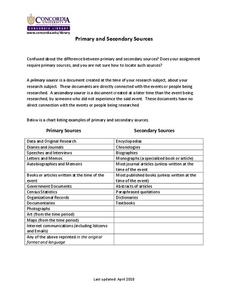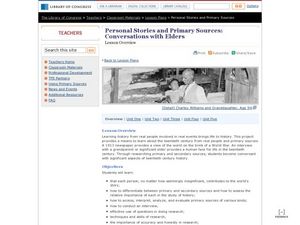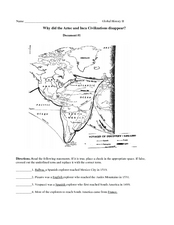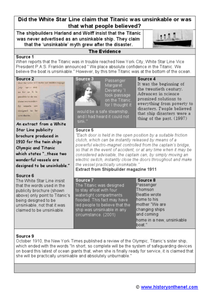ReadWriteThink
Captioning the Civil Rights Movement: Reading the Images, Writing the Words
Scholars boost their knowledge of the Civil Rights Movement with a lesson plan that challenges writers, readers, and historians to analyze primary sources and caption their observations. By way of reading, writing, discussion,...
Angel Island Immigration Station Foundation
Leaving Home Forever: What Would You Put In Your Suitcase?
Scholars put themselves in an immigrant's shoes to decide what items they would take on their journey to a new home. Learners read primary sources, take part in a whole-class discussion, and make a list that they share with their peers,...
Curated OER
The Wrights' Flight: History Through Primary Sources
Pupils read primary source material about the Wrights' first flight such as a journal and a telegram. In this The Wrights' Flight lesson, students select the most reliable primary source and compare the pros and cons of using primary...
Curated OER
Introduction of Primary Sources
First graders examine a database to explain the use of primary source documents.
Concordia University
Primary and Secondary Sources
Show your class the difference between primary sources and secondary sources. The first page provides a list of examples of each type of source. While they research, pupils can refer back to the list quickly to make sure they are reading...
Shmoop
ELA - Literacy.CCSS.ELA-Literacy.RH.9-10.1
Do your pupils know what a primary source is? How about a secondary source? Provide them with the information here about different types of documents and then test their knowledge with a brief quiz. The quiz is made up of two documents....
Curated OER
Woody Guthrie: Life and Art
Woody Guthrie will capture the imagination of even your most reluctant learners. Using his work, your class will develop their skills in non-fiction reading comprehension, interpreting primary source material, and use of multiple forms...
Curated OER
Personal Stories and Primary Sources: Conversations with Elders
Students learn from their elders. In this oral and social histories lesson, students analyze primary sources to develop an understanding of the America in which their grandparents grew up. Students conduct interviews with elders in...
Center for History Education
Debating Social Security: Understanding and Evaluating the Social Security Act of 1935
With throngs of Americans out of work and hungry, Franklin D. Roosevelt made the bold move to establish a social safety net with programs such as Social Security. The move was—and still is—controversial. Using documents from the 1930s,...
Curated OER
Can you Prove it?
Tenth graders examine how primary source documents help authors and museum curators interpret historic events. In this social studies lesson plan, 10th graders research primary source documents. Students create a powerpoint to present...
National Endowment for the Humanities
The Question of Representation at the 1787 Convention
While the Constitution is considered enshrined today, its current form is the result of haggling at a secret convention in 1787. Using transcripts from the meetings and various plans as drafted by the delegates, class members unpack the...
National Endowment for the Humanities
Creating the Office of the Presidency
The United States needed an executive power, but it wanted to avoid a monarchy. Using James Madison's notes on the Constitutional Convention, young historians look at the juggling act the Founding Fathers did to create a role for the...
Curated OER
All Aboard
Explore the U.S.S. Nevada. Researchers use primary sources, secondary sources, children's books and websites to study the naval ship. Their study commences with a class alphabet book on the ship. Intended to be part of a instructional...
Curated OER
Mr. Lincoln's Whiskers
Learn about the events that helped shape the United States of America. Elementary schoolers explore the Civil War with six different activities. Each activity has a different focus: literature connections, primary sources, vocabulary,...
Curated OER
Why did the Aztec and Inca civilizations disappear?
Middle schoolers can analyze primary source documents to answer the question, "Why did the Aztec and Inca civilizations disappear?" They will read the provided excerpts then answer 11 different questions to uncover the ultimate answer.
Curated OER
White Star Line and the Titanic
Was the Titanic advertised as an unsinkable ship, or was it just what the public believed? In this analysis activity, historians examine both primary and secondary sources to determine the answer to this question and the reliability of...
National History Day
Challenging the Status Quo: Women in the World War I Military
Why are some so resistant to change? The status quo is often to blame for a lack of forward movement in society. Following the events of World War I, women in America suddenly had a voice—and were going to use it. Scholars use the second...
Curated OER
Liberty Rhetoric
What is liberty rhetoric? Examine how people have used it in four different time periods and situations. High schoolers investigate original source documents and compare them with the Declaration of Independence to decide how liberty...
Curated OER
Revolt
Knowing what questions to ask and knowing how to organize information found is often difficult for young researchers. Consider using this activity to help guide a revolutions research project. Researchers are first directed to examine...
Curated OER
Document Analysis Sheet
Sometimes all kids need is a little guided practice and then they can be on their way. They can use an analysis worksheet to help them analyze a primary or secondary source document. They answer several questions describing the type of...
Curated OER
The Third Estate
Kids read a translated version of Abbe Sieyes' document, The Third Estate. This document is shown in its original form and as an English translation. After reading the text they answer three critical thinking question to show their...
Curated OER
French Revolution: The Declaration of Pillnitz
Answering document-based questions increases critical analysis and comprehension skills. The class reads a passage from The Declaration of Pillnitz then answers three critical thinking questions.
Curated OER
The Dust Bowl
Use this presentation to discuss the causes and effects of The Dust Bowl, or to establish a historical context for the book, The Grapes of Wrath. Found here are images, eye-witness quotes, and some ideas as to the causes and effects of...
American Battlefield Trust
John Brown
How did the raid on Harper's Ferry contribute to the start of the Civil War? Curated for high school historians, the activity explains John Brown's contribution to the start of the Civil War by using violence to demand an end to slavery....
Other popular searches
- Using Primary Sources
- Wwi, Primary Sources
- Rosa Parks Primary Documents
- Gilded Age Primary Sources
- Working With Primary Sources
- Primary Resources Hsie
- Web Quests Primary Sources
- Ancient Rome Primary Sources
- 1920 1929 Primary Sources
- Primary Sources and Family
- Conscription Primary Sources
- Scotland Primary Sources

























